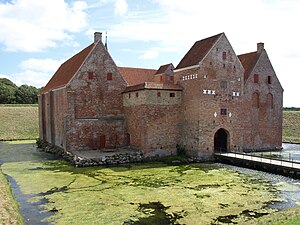Spøttrup Castle
| Spøttrup Castle | ||
|---|---|---|
|
Spøttrup Castle |
||
| Creation time : | around 1500 | |
| Castle type : | Moated castle | |
| Conservation status: | Received or received substantial parts | |
| Place: | Skive | |
| Geographical location | 56 ° 38 '22.6 " N , 8 ° 46' 57.7" E | |
|
|
||
Spøttrup Castle is one of the oldest mansions in Denmark and is considered the best preserved medieval castle in the country. It is located at the foot of a hill in a meadow that used to be a lake, in the former Spøttrup municipality , northwest of Skive in the Salling region in Jutland .
A trench surrounded by a nine meter high wall and an outer ring trench formed its protection. The castle can be reached via the dam running between the Au and the outer ring moat. Drawbridges , the construction of which was revealed during the restoration, lead over the trenches . After the restoration, which was completed in 1941, the castle has regained part of its medieval character. It is made of brick and features features of both Gothic and Renaissance styles.
history
Spøttrup belonged in the 14th century to Niels Buggesen Bugge til Hald (1295-1358), who was the leader of a nobility revolt against Waldemar Atterdag and was murdered in 1358. He was probably the richest prince in Denmark in his day and was called "King Bugge". In addition to Spøttrup and Hald, he owned the castles and mansions Åstrup, Estrup, Lindholm near Skagen, Nørre Vosborg, Rolstrup am Mors, Støvringgård and several other properties, especially in the northern part of Nørrejylland.
In 1404 the aristocrat Johan Skarpenberg donated the castle grounds to the Bishop of Viborg . Niels Glob (Bishop of Viborg from 1478 to 1498) or his successor Erik Kaas (1508–20) must have built a red brick castle around 1500 . Two parallel longhouses were connected by a shorter wing. A shield wall and a tower projecting in the middle enclosed the west side of the courtyard. Originally the buildings were one floor higher. At the top there was a shooting ground intended for defense. On three sides of the outer wall you can see so-called secrets, masonry latrine channels that once went from the Schützenboden to the moat and were restored on the occasion of the restoration.
The gate tower and the wide shield wall that can be walked on in the upper part are among the best preserved parts. There are six loopholes at the barrel-vaulted castle gate , from which the moat could be painted. There are four similar niches in the shield wall.
On the main floor, the castle initially had high, wide windows, which, facing the moat, meant a serious danger. During the restoration it was found that they had been walled up and turned into narrow loopholes with machicolation. This probably took place on the occasion of the so-called count feud in 1534, when the castle was set on fire, but the attackers were unable to conquer it.
After the Reformation , the castle came into the possession of the crown in 1536. In 1579 it was bought by the nobleman Henrik Below . He converted the south wing into a befitting apartment. The floors have been redistributed. The magnificent ballroom on the first floor was given rib-free Renaissance vaults . An apartment was set up above the ballroom. It was probably given the room layout that it still has today. Doors and paneling were added later. The south wing received large, flat-arched windows, and the two stair towers in the corners of the courtyard were erected. An exposed outside staircase had previously been used. The other two wings were used almost unchanged as utility rooms and servants' quarters. The shield wall was designed lower and a covered battlement, which was led around the corner to the north wing, so that the north and south wings were easily accessible on the upper one.
For a while, the subsequent owners of Spøttrup Castle lived in Holstein. At the beginning of the 18th century, the castle was reigned by a lordship, which Axel Rosenkrantz and his wife Karen Reedtz bought from Paul Kohlblatt. The Rosenkrantz belong to the oldest noble families in Denmark and come from Scania , where they were expelled when the area became Swedish in 1659 . In 1702, her son Mogens furnished the baroque apartment on the second floor with panels and doors and frames that end in cute claws.
The castle underwent major changes in the 19th century. Among other things, the vaults on the bottom floor of the north wing were removed and a distillery was set up there. Around 1871 the wall was razed on the west and south sides.
After the castle was taken over by the state in the 1930s, it was thoroughly restored. It was decided to preserve the castle's renaissance style, but at the same time to bring out what was of value from earlier times. So the secrets were re-enacted. The medieval division with the very high central storey was restored in the east wing, and the large bricked-up windows were opened again. The Renaissance vaults were restored in the north wing. The looped sections of the wall were also rebuilt and buried moats dug up.
To the east of the castle, a small renaissance garden with medieval herbs and medicinal plants, as well as a well-known garden area were set up, the flower beds of which surround the castle with bright colors. Medieval games are now regular events against the backdrop of the castle.
Festival
Spøttrup Castle hosted the “European Championship for Knights” from July 23-27, 2012. 16 knights from all over Europe take part in the international tournament.
Nearby
North is a passage grave in the Ginderup plantation and Krejbjerg Stordysse .
See also
List of castles, chateaus and fortresses in Denmark


